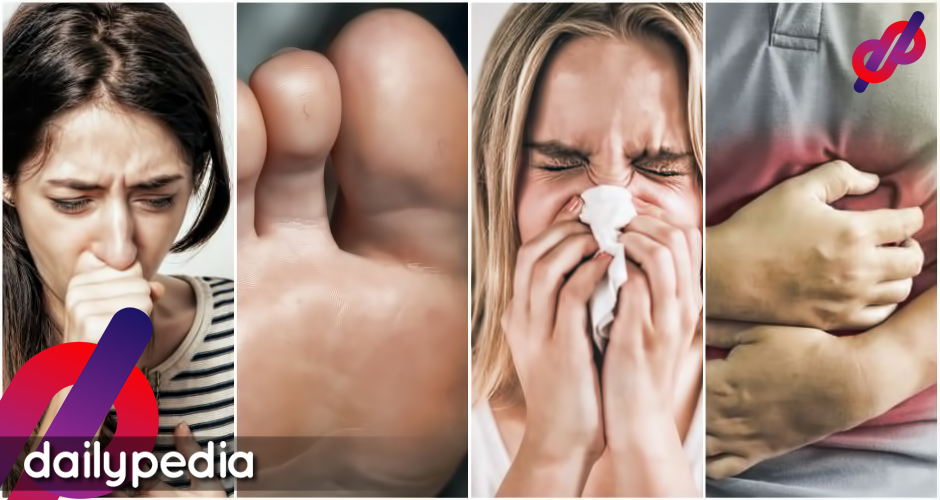Much is yet to be known about the new coronavirus, but as the days go by, more and more information is discovered.
There are actually subtle signs that indicate one might have already been infected by the coronavirus.

“The majority of people who contract the coronavirus will experience mild symptoms, the most common being a high temperature and a new, dry and continuous cough. A smaller percentage of people will experience more severe symptoms,” explains Dr. Daniel Atkinson, GP Clinical Lead at Treated.com.
Below are the 10 subtle signs.
1. Runny Nose, Sore Throat, and Congestion
Dr. Atkinson says that having a runny nose, sore throat, and congestion, can indicate a mild case of COVID-19. However, because it “sounds, and likely feels, a lot like the common cold, or a hay fever allergy,” most would just ignore it and see it as nothing serious.
2. Reduced, or Loss of, Sense of Taste and Smell
Loss of taste and smell is a common symptom of COVID-19. Dr. Atkinson says “It’s a symptom that might accompany really mild symptoms, like those not dissimilar to the common cold—runny nose, congestion, and sore throat—but it can also accompany the very mild symptoms, such as muscle aches, fatigue, fever, and a continuous cough,”
Many infected individuals report that their senses return after less than a week, but it there is no clear explanation why it would vanish when getting infected.
3. Reduced Appetite
The previous symptoms can only make things worse when one is also experiencing a loss of appetite. It is important to stay hydrated.
“If this is accompanied by a loss of taste and smell it can make wanting to eat or drink really difficult. It’s really important to drink plenty of fluids to help your body combat the virus and minimize the symptoms and even if you don’t feel like it, try to eat something, even if it’s just a snack or a small meal,” he said.
4. Breathlessness
Coughing, sore throat, and breathlessness are good indicators of COVID-19, explains Dr. Atkinson. In the event breathlessness occurs even when you’re at rest, then that is a good sign you have been infected.
5. Tiredness and Fatigue
The human body uses a lot of energy when fighting an infection, hence tiredness and fatigue.
Dr. Atkinson says exercising while suffering from an infection isn’t advisable.
“Most people will feel tired or lethargic so won’t be exercising or going to work when they’re ill but some fitness enthusiasts insist on continuing with exercise to try and battle on through,”
“You should not ignore your body’s signals. Resting and sleeping while you’re unwell is an essential part of your recovery.”
6. “COVID Toes”
Having recovered from COVID-19 might cause some markings on one’s toes.
Caroline Nelson, MD, a Yale Medicine dermatologist, said, “The skin is often a window into a person’s health and may show subtle signs of COVID-19 infection.”
According to Dr. Nelson, Morbilliform (“measles-like”) exanthems (many, often symmetric, pink-to-red bumps that can merge together) and hives (itchy red wheels on the skin) have been associated with COVID-19 infection.
“They are found most often in otherwise asymptomatic children and young adults,” says Dr. Nelson.
“It is important to note that these skin signs are non-specific, meaning that they can be associated with other infections, systemic disorders, and medication reactions. It is important to seek medical advice from your physician.”
7. Pink Eye
COVID-19 has also been said to cause pink eye, as found with cases that have recovered.
The American Academy of Ophthalmology recently confirmed this in a statement.
“Several reports suggest that SARS-CoV-2 can cause a mild follicular conjunctivitis otherwise indistinguishable from other viral causes, and possibly be transmitted by aerosol contact with conjunctiva.”
Experts have advocated for people wearing contact lenses to switch to glasses amid the crisis.
8. Diarrhea or Nausea
The CDC said, “Some persons with COVID-19 have experienced gastrointestinal symptoms such as diarrhea and nausea prior to developing fever and lower respiratory tract signs and symptoms.”
A study published in The American Journal of Gastroenterology reveals that these problems are very common were COVID-19 patients.
Brennan Spiegel of Cedars-Sinai Medical Center in Los Angeles confirmed this, saying that a great number of COVID-19 patients have experienced diarrhea.
Douglas Corley of Kaiser Permanente, Northern California, co-editor of Gastroenterology said, “If you mainly have fever and diarrhea, you won’t be tested for COVID.” This is because the CDC still doesn’t recognize gastrointestinal disorders as COVID-19 symptoms.
9. A Fever Spike
Fevers that just come and go away immediately could mean that you’ve been infected.
The WHO says this is the most common symptom, with 87.9% of 55,924 laboratory-confirmed cases of coronavirus reported a fever.
10. Muscle Pain
Body aches, pains, and soreness are all symptoms of coronavirus, according to the CDC.
The lungs are the main target of the virus, as mentioned by Hongbo Jia, a neuroscientist at the Chinese Academy of Sciences’ Suzhou Institute of Biomedical Engineering and Technology.
“The lung is the primary battle zone. But a fraction of the virus possibly attacks the kidney. And as on the real battlefield, if two places are being attacked at the same time, each place gets worse.”
From the lungs, the virus then attacks other organs, which causes multi-organ failure.
Not a lot of people know that the immune system itself also plays a big role in damaging the human body. When the immune system overreacts in fighting a virus, it ends up attacking and killing healthy cells.
Jamie Garfield, a pulmonologist who at Temple University Hospital said, “The real morbidity and mortality of this disease is probably driven by this out of proportion inflammatory response to the virus.”
The virus can also attack the brain and has caused patients to suffer from stroke.


